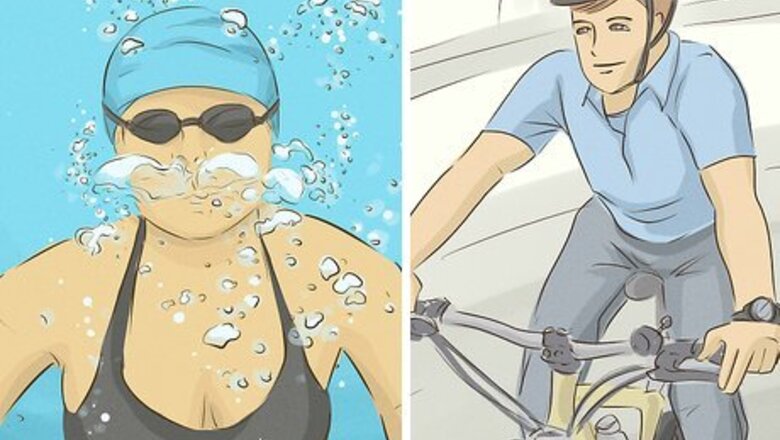
views
Limiting Knee Stress While Exercising
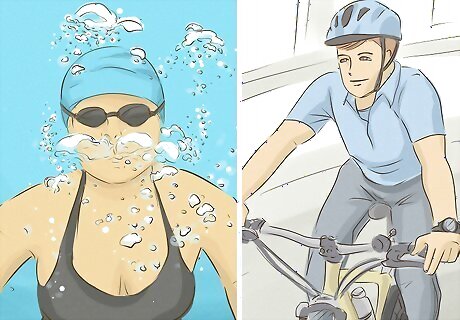
Focus on low-impact aerobic exercises like biking and swimming. The less pressure you place on your knees while exercising, the less likely you are to experience knee pain. For cardiovascular health benefits, aim for 150+ minutes of moderate-intensity aerobic exercise per week, prioritizing activities with low knee impact such as: Swimming and water aerobics. The buoyancy of the water limits knee stress. Stationary biking or outdoor biking. Brisk walking on a soft, level surface like a synthetic track or grass. Using an elliptical machine (as opposed to a treadmill). Talk to your doctor before beginning any new exercise program, especially if you have existing knee issues or other health concerns, or live a sedentary lifestyle.
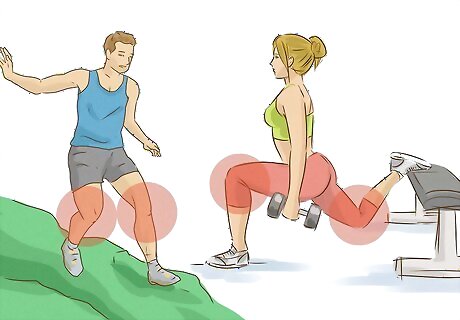
Limit high-stress exercises like deep knee bends and downhill running. While they’re great forms of aerobic exercise, running or jogging, especially on a hard surface like asphalt, can be brutal on your knees. They’re even harder on your knees if the surface is uneven or goes largely downhill. Don’t do deep knee bends, full squats, or full lunges if you have a history of knee discomfort or if your doctor recommends against them. You may be able to do partial knee bends, squats, or lunges instead.
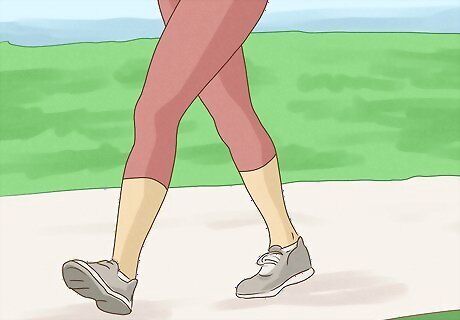
Warm up before exercising and cool down afterward. For instance, if you’re going to walk around a synthetic track for 30 minutes at a moderate pace, spend 5-10 minutes beforehand walking at a slower but steadily-increasing pace. Then, spend another 5-10 minutes afterward walking at a steadily-decreasing pace. Similarly, swim several slow-pace laps before and after doing your typical lap swim. Warming up helps loosen your joints and muscles, reducing the chance of discomfort and possibly injury. Cooling down can help to reduce stiffness and soreness after exercising.
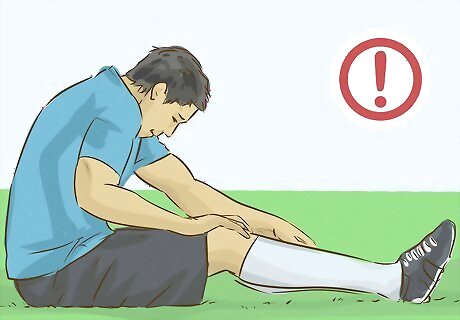
Stop what you’re doing if you feel knee discomfort. Don’t try to exercise your way through discomfort in a misguided attempt to strengthen your knees. Knee discomfort is a sign that the joint has been overly stressed or that there are developing structural issues. Cut short your exercise session and rest your knee until the discomfort is gone. Try icing your knee in 10-15 minute sessions with an ice pack wrapped in a towel. Or, try alternating a wrapped ice pack and a heating pad or warm, moist towel. Stop exercising and contact your doctor if you feel outright pain in one or both knees.
Working Your Knees and Surrounding Muscles
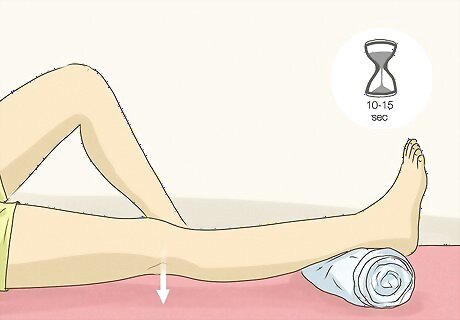
Improve your range of motion with prone knee flexes. Lie down on your back, either on an exercise mat on the floor or in a bed with a firm mattress. Place a small pillow or rolled-up towel beneath one ankle. Slowly flex the knee of the elevated leg slightly downward and hold the flex for 10-15 seconds. Do 10-15 repetitions (reps), then switch legs. Ask your doctor or physical therapist before doing this exercise, and don’t do it if it causes you discomfort or pain. Do this exercise once per day unless otherwise recommended.
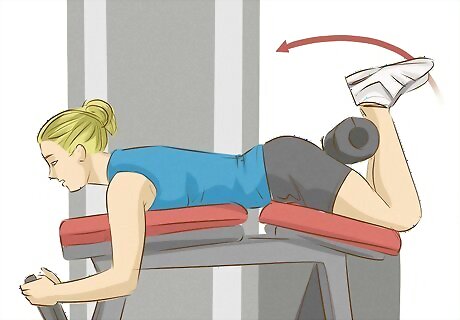
Exercise your hamstrings and quads to reduce strain on your knees. If your hamstrings and quads are stronger and more flexible, they’ll be able to assume more of the load that’s currently being put on your knees. Try 10-15 reps of each of the following exercises once per day, unless otherwise recommended: Step-ups. Step up onto a step stool or the first step of a flight of stairs, then step back down using the same leg. Hold the stair railing if you need balance support. Switch legs after 10-15 reps. Hamstring curls. Lie face-down on an exercise mat, slightly propping up your head with your crossed arms or a small pillow. Bend one leg up behind you so your heel points toward your rear end. Switch legs after 10-15 reps. Straight-leg lifts. Lie on your back on an exercise mat. Bend one knee at a 90-degree angle while keeping your foot flat on the mat. While keeping the other leg straight, lift it no more than 6 in (15 cm) off the mat, then lower it slowly. Switch legs after 10-15 reps.
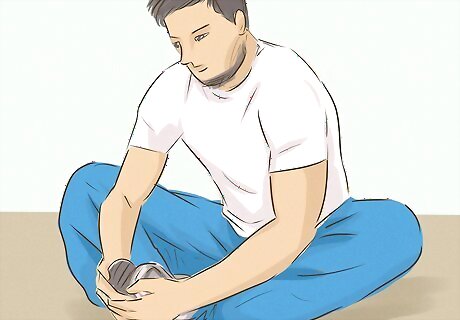
Stretch your hips to keep your body in better alignment. As with the muscles in your legs, improving your hip flexibility can help to relieve some of the pressure placed on your knees. Unless advised otherwise, try doing the following exercises once per day: Butterfly stretches. Sit on an exercise mat with your knees pointed outward, the outsides of your feet resting on the mat, and the soles of your feet touching. Keeping your back straight, lean forward until you feel light resistance in your hips, and hold the position for 30-60 seconds. Standing hip flexors. Stand upright with one foot forward like you’re taking a normal-sized step. Slowly and slightly bend your front knee and lean forward, keeping your back straight and your back foot in place. Hold the stretch for 30-60 seconds, then switch legs and repeat the maneuver.
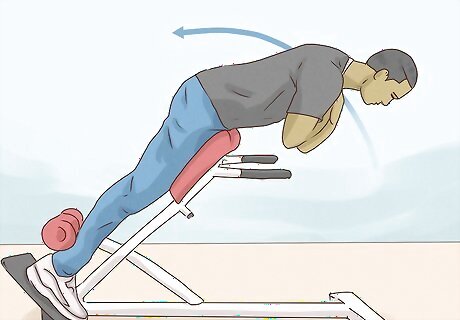
Strengthen your core muscles to improve your posture. Poor posture causes uneven weight distribution and can significantly increase the strain placed on your knees. Building up your core muscles is critical to improving your posture. Try the following once per day unless recommended otherwise: Planks. Position yourself face-down on an exercise mat with only your toes, knees, and forearms resting on the mat. Raise your knees off the mat, keeping your legs and back straight, and engage your abs and glutes. Hold the pose for 15-45 seconds, relax, and repeat 1-2 more times. Back extensions. Lie face-down on an exercise mat with your palms flat on the mat and your elbows bent. Keep your legs and hips against the mat while using your arms to slowly raise your upper body off the mat. Hold this pose for 5-10 seconds, and do a total of 5-10 reps.
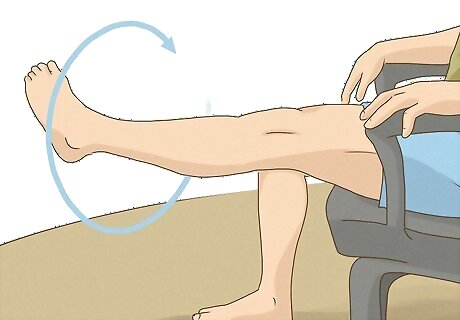
Do foot exercises to strengthen your feet. Since your feet support your knees, it's important to take care of your feet and arches to prevent heel pain. Stretch your feet every day to help keep them strong. Here are some foot exercises you could try: Sit in a chair with your feet flat on the floor. Then, lift 1 foot off the floor and draw big circles in the air with your big toe. Do 15-20 rotations, then reverse and go the other direction. Then, switch legs. Stand up with your feet together and step back with 1 leg. Press the ball of your feet into the floor and leave that heel raised off the floor. You should feel a light stretch in your foot. Hold for 20-30 seconds, then repeat on the other side. Loop a resistance band around a sturdy piece of furniture, then sit in a chair across from it. Place the resistance band around the top of your foot. Then, pull back on the top of your foot to stretch it. Hold for 3-5 seconds, then do 10-15 repetitions. Repeat on the other side.
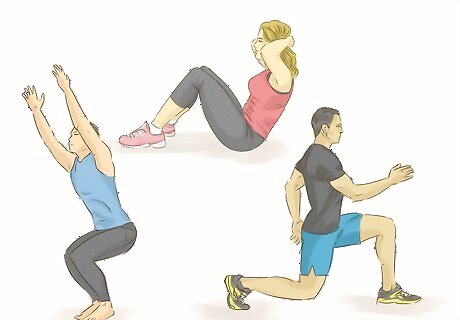
Work your hips and core to provide more stability for your body. Strong hips also help support healthy knees, so make sure you're working them 2-3 days per week. Take at least a 24-hour break between hip and core workouts, but it's okay to work other muscle groups or do cardio on those days. Here are some exercises to try: Do floor exercises like abdominal curls, crunches, push ups, and leg lifts. To really work your hips, try lunges and side squats. You can also do yoga.
Making Lifestyle Changes
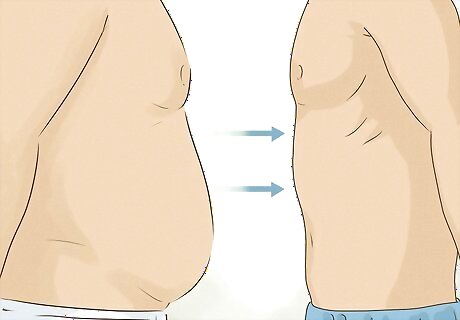
Work to achieve or maintain a healthy weight. Losing 10 lb (4.5 kg) can cause a 20% reduction in knee pain if you’re overweight and have arthritis. If you’re overweight but don’t yet have knee pain due to arthritis or another condition, losing weight in a healthy manner is a great preventative measure. Work with your doctor to determine if you should lose weight, what your weight loss goal should be, and how best to achieve it. If you’re already at a healthy weight, don’t try to lose additional weight without your doctor’s guidance. Opt for slow, steady, healthy weight loss—averaging about 1 lb (0.45 kg) per week—by exercising regularly, eating fewer calories, and choosing nutritious foods like fruits and vegetables, lean proteins, whole grains, and healthy fats.
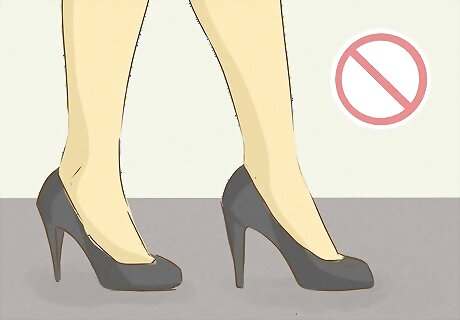
Wear comfortable shoes and avoid high heels. If your footwear provides a poor base for your body weight, your knees will suffer most. Shoes that fit properly and have cushioned soles can take a great deal of pressure off of your knees, making knee pain less likely. Avoid wearing high heels as much as possible. Consider going to a specialty shoe shop where you can be expertly fitted for shoes that meet your needs.
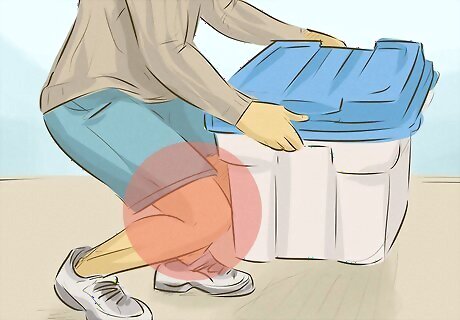
Avoid squatting while doing activities like gardening. When you’re bent down into a full squat, your knees experience several times the pressure as when you’re standing normally. If you frequently squat to do activities like gardening, opt instead for a low bench that you can carry around and sit on as needed. Search online for a “gardening bench,” or check out medical supply stores for benches intended for patients with knee pain.
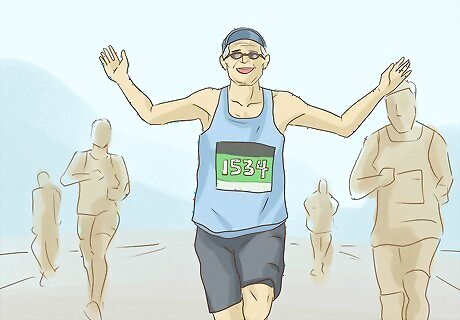
Visualize your goals for wanting healthy knees. If you don’t have frequent knee pain yet, it can be hard to stay motivated to take the necessary steps to prevent knee pain. To improve your motivation, imagine activities which will be much easier or more enjoyable with healthy knees. If you have grandkids on the way, visualize yourself playing with them down on the floor. Envision yourself crouching behind home plate as a youth baseball umpire for years to come. Picture yourself completing the half marathon held in your city.
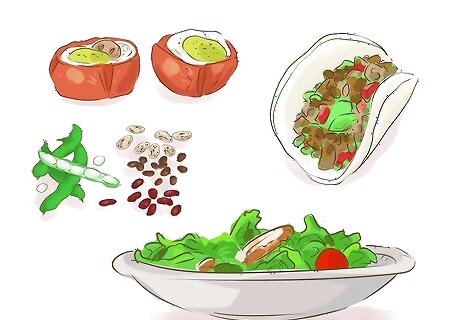
Try an anti-inflammatory diet to reduce inflammation. Inflammation in your body can cause or worsen joint pain, including pain in your knees. Since the food you eat can trigger inflammation, it's best to follow an anti-inflammatory diet. You might try 1 of the following diets to relieve your inflammation: The Mediterranean diet can help manage inflammation in your body. Some foods can trigger inflammation in your body, so you might try an elimination diet to find your triggers. Eliminate common trigger foods like dairy, wheat, sugar, soy, gluten, and red meat for at least 30 days. Then, add them back 1 food at a time to see if your body reacts. Stop eating foods that make you feel bad. Other options include a paleo diet, a grain-free diet, or intermittent fasting. Try them and see if they work for you.



















Comments
0 comment